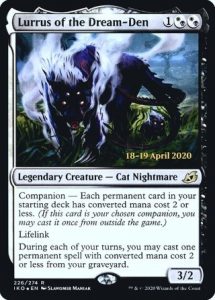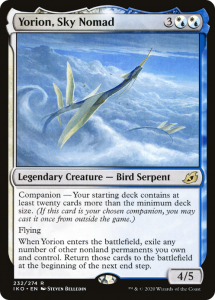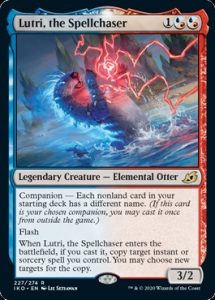It’s been too long since we last dove into the mechanics of Magic: the Gathering. Although it’s fun to discuss things like who the hottest planeswalkers are, it’s always important to get into the nitty-gritty details of the game, too.
To be honest, we might be a little late to the party on this one, but in this post, we’re going to be taking a look at how Companion works in MTG. In addition to giving you a high-level overview of what the mechanic is, we’ll answer some commonly asked questions about it.
What is Companion and How Does it Work?

Let’s begin with a really basic and high-level overview of what the heck Companion is before we get to the more complicated questions. Companion is a keyword that was first introduced in the Ikoria: Lair of Behemoths set. You can see it on the card pictured above, Lurrus of the Dream-Den.
What Companion does varies based on the card in question. It essentially gives you the ability to use the Companion card as an extra card if you build your deck a particular way. For example, Lurrus requires all permanents in your deck to have a converted mana cost of two or less. If you meet that requirement, you can use Lurrus as a Companion.
If you meet a card’s Companion requirement and choose to use that card as a Companion, it’s sort of like getting an extra card, except it doesn’t start in your library. The Companion card doesn’t get to be included in your main deck, but it does get to be placed in your sideboard. Even if you’re not using a sideboard, you still get access to the Companion card.
It’s important to note that you can only choose one Companion card. All players who are using Companion cards must also declare who their Companions are before the game starts.
So, if the Companion isn’t in your library, how do you cast it? Currently, the rules stipulate that you must pay three mana in order to pull the Companion into your hand. You can do this at any time you could cast a Sorcery and other players cannot respond to it.
Mutate was another mechanic introduced in Ikoria: Lair of Behemoths. We’ve written a post about how Mutate works in MTG if you have any questions about it, too.
How Does Companion Work with Sideboarding?
One question we saw quite a few people asking is how Companion works in regard to your sideboard. We’ll dive into that a little bit after a brief explanation on what sideboards are.
If you’re a beginner, a sideboard is defined as some additional cards separate from your library that you can edit your deck with in between games. Many competitive players use sideboards as a way to respond to threats at tournaments. For instance, if they notice a trend in competitor decks, they can dip into their sideboard after a few games to swap out some cards in their own as a response to that trend.
Assuming you’re using a sideboard, your chosen Companion card starts in your sideboard. Additionally, your Companion does count towards the number of cards in your sideboard, so just keep that in mind.
What Happens When Your Companion Dies in MTG?
Once you pay the cost for your Companion to be moved to your hand, it is a part of that game until the game ends. If you cast it, it behaves like the other cards in your deck. Thus, if it dies, it goes to your graveyard just like any other card.
How Does Companion Work in EDH/Commander?

There isn’t really any difference for Companions in Commander. Like with other formats, you have the option of including a single Companion card with your deck.
It does not count towards the number of cards in your deck. Remember, in Commander/EDH, you must have exactly 100 cards total, including your actual Commander. Since your Companion doesn’t count, you cannot include it in that total.
One interesting thing to note here is that this means you couldn’t use Yorion, Sky Nomad as a Companion in EDH because its rule requires you to have at least 20 cards over the minimum number in a given format. Because Commander stipulates you use exactly 100 cards in your deck (excluding your Companion), you can’t have any extra, therefore automatically failing to meet Yorion’s requirement.
Is Companion Banned in Commander?

No, the Companion mechanic is not currently banned in Commander. That being said, there is one notable exception where a specific Companion card was banned from the format. Said card, pictured above, was Lutri, the Spellchaser.
Lutri was actually banned from Commander the very day it was spoiled. So why was this adorable (and simultaneously frightening) little otter banned?
Look at Lutri’s Companion requirement: “Each nonland card in your starting deck has a different name.” This is not a deterrent when building a Commander deck because it’s already a requirement. The Commander format stipulates that, aside from basic lands and a few other exceptions, you cannot have multiple cards of the same name.
In other words, if you’re building a red/blue Commander deck, Lutri is like a free extra card that doesn’t count towards your deck total. There’s absolutely no reason not to include it. If it were allowed, you’d see people constantly putting it in red/blue decks, causing the format to stagnate and the price of the card to skyrocket.
Beyond Lutri, the only other Companion card we know of at this point in time that you can’t use in Commander is Yorion, Sky Nomad. With Yorion, this is simply because its Companion requirement is not compatible with the format.
The Benefits of Companion
With all that in mind, Companion isn’t a bad mechanic at all. It has its uses, with the primary benefit being that you’re essentially getting a free extra card you can use.
Plus, you’re getting some consistency when you use a Companion. As an illustration of that point, consider Commander cards in EDH/Commander.
One of the reasons Commanders are so powerful is that you always have access to them, since they generally wait in the Command Zone until they’re cast. Usually, getting to play them doesn’t come down to the luck of the draw.
The same benefit applies to Companion cards. They add some much-needed consistency to your deck, because you always know where they are. Provided you can pay the mana cost to put them in your hand and then the cost to cast them, you can always depend on them.
The Drawbacks of Companion
There are very few things in Magic: the Gathering that can be said to have no downside. This applies to Companion, too.
Remember, your deck has to meet the Companion’s requirements in order to use it. You cannot just put any Companion in any deck and call it good. If you’re a beginner just learning how to build a deck, working around these restrictions can be difficult and frustrating.
Furthermore, the restrictions of a Companion can limit what archetypes it works with. Take Lurrus, for example, who we featured at the beginning of this post.
Lurrus is really good. In fact, it is so good that it broke the Vintage and Legacy formats, thanks to its requirement, which states you can’t have any permanents in your deck that cost more than two mana. (Many Vintage and Legacy decks naturally have low mana curves, anyway, and have numerous powerful cards to choose from that cost two or less.)
But if you were trying to build a Reanimator-style deck, which relies on pulling big, beefy creatures from your graveyard, you’d struggle to make Lurrus work. With Lurrus’s ability, you cannot have high-costed permanents in your deck, thus making many large creatures impossible.
Wrap Up
At the end of the day, we feel as if Companion is a fun mechanic to use. At the time of writing this post, we haven’t personally incorporated many Companions into our decks yet, but it’s something we look forward to experimenting with in time.
Depending on your preferred format, there are limitations to using Companions. However, with a little research and patience, you can usually work around these limitations to make decks that are both powerful and a blast to play. If you’d like to learn more about other mechanics in the game, try reading our post regarding how Adventure works.
